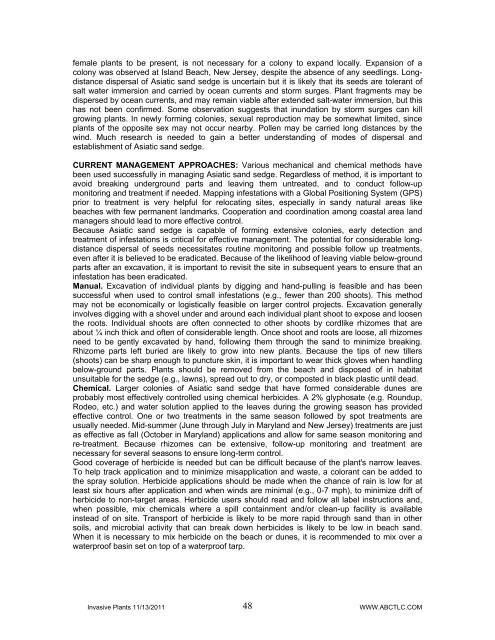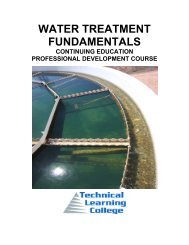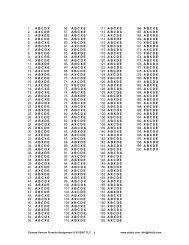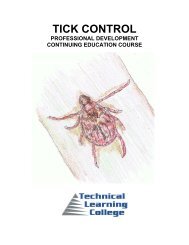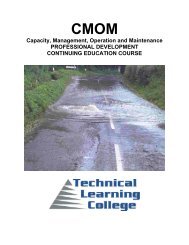INVASIVE PLANTS - Technical Learning College
INVASIVE PLANTS - Technical Learning College
INVASIVE PLANTS - Technical Learning College
You also want an ePaper? Increase the reach of your titles
YUMPU automatically turns print PDFs into web optimized ePapers that Google loves.
female plants to be present, is not necessary for a colony to expand locally. Expansion of a<br />
colony was observed at Island Beach, New Jersey, despite the absence of any seedlings. Longdistance<br />
dispersal of Asiatic sand sedge is uncertain but it is likely that its seeds are tolerant of<br />
salt water immersion and carried by ocean currents and storm surges. Plant fragments may be<br />
dispersed by ocean currents, and may remain viable after extended salt-water immersion, but this<br />
has not been confirmed. Some observation suggests that inundation by storm surges can kill<br />
growing plants. In newly forming colonies, sexual reproduction may be somewhat limited, since<br />
plants of the opposite sex may not occur nearby. Pollen may be carried long distances by the<br />
wind. Much research is needed to gain a better understanding of modes of dispersal and<br />
establishment of Asiatic sand sedge.<br />
CURRENT MANAGEMENT APPROACHES: Various mechanical and chemical methods have<br />
been used successfully in managing Asiatic sand sedge. Regardless of method, it is important to<br />
avoid breaking underground parts and leaving them untreated, and to conduct follow-up<br />
monitoring and treatment if needed. Mapping infestations with a Global Positioning System (GPS)<br />
prior to treatment is very helpful for relocating sites, especially in sandy natural areas like<br />
beaches with few permanent landmarks. Cooperation and coordination among coastal area land<br />
managers should lead to more effective control.<br />
Because Asiatic sand sedge is capable of forming extensive colonies, early detection and<br />
treatment of infestations is critical for effective management. The potential for considerable longdistance<br />
dispersal of seeds necessitates routine monitoring and possible follow up treatments,<br />
even after it is believed to be eradicated. Because of the likelihood of leaving viable below-ground<br />
parts after an excavation, it is important to revisit the site in subsequent years to ensure that an<br />
infestation has been eradicated.<br />
Manual. Excavation of individual plants by digging and hand-pulling is feasible and has been<br />
successful when used to control small infestations (e.g., fewer than 200 shoots). This method<br />
may not be economically or logistically feasible on larger control projects. Excavation generally<br />
involves digging with a shovel under and around each individual plant shoot to expose and loosen<br />
the roots. Individual shoots are often connected to other shoots by cordlike rhizomes that are<br />
about ¼ inch thick and often of considerable length. Once shoot and roots are loose, all rhizomes<br />
need to be gently excavated by hand, following them through the sand to minimize breaking.<br />
Rhizome parts left buried are likely to grow into new plants. Because the tips of new tillers<br />
(shoots) can be sharp enough to puncture skin, it is important to wear thick gloves when handling<br />
below-ground parts. Plants should be removed from the beach and disposed of in habitat<br />
unsuitable for the sedge (e.g., lawns), spread out to dry, or composted in black plastic until dead.<br />
Chemical. Larger colonies of Asiatic sand sedge that have formed considerable dunes are<br />
probably most effectively controlled using chemical herbicides. A 2% glyphosate (e.g. Roundup,<br />
Rodeo, etc.) and water solution applied to the leaves during the growing season has provided<br />
effective control. One or two treatments in the same season followed by spot treatments are<br />
usually needed. Mid-summer (June through July in Maryland and New Jersey) treatments are just<br />
as effective as fall (October in Maryland) applications and allow for same season monitoring and<br />
re-treatment. Because rhizomes can be extensive, follow-up monitoring and treatment are<br />
necessary for several seasons to ensure long-term control.<br />
Good coverage of herbicide is needed but can be difficult because of the plant's narrow leaves.<br />
To help track application and to minimize misapplication and waste, a colorant can be added to<br />
the spray solution. Herbicide applications should be made when the chance of rain is low for at<br />
least six hours after application and when winds are minimal (e.g., 0-7 mph), to minimize drift of<br />
herbicide to non-target areas. Herbicide users should read and follow all label instructions and,<br />
when possible, mix chemicals where a spill containment and/or clean-up facility is available<br />
instead of on site. Transport of herbicide is likely to be more rapid through sand than in other<br />
soils, and microbial activity that can break down herbicides is likely to be low in beach sand.<br />
When it is necessary to mix herbicide on the beach or dunes, it is recommended to mix over a<br />
waterproof basin set on top of a waterproof tarp.<br />
Invasive Plants 11/13/2011 48<br />
WWW.ABCTLC.COM


